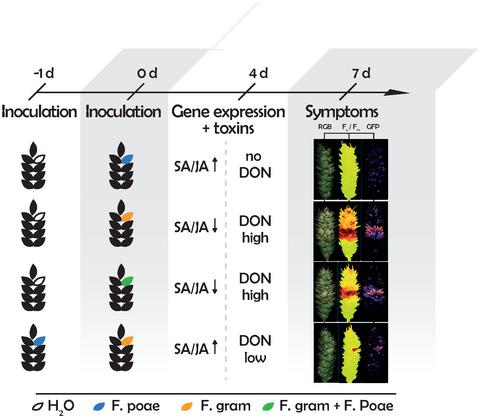当前位置:
X-MOL 学术
›
Mol. Plant Pathol.
›
论文详情
Our official English website, www.x-mol.net, welcomes your
feedback! (Note: you will need to create a separate account there.)
At the scene of the crime: New insights into the role of weakly pathogenic members of the fusarium head blight disease complex
Molecular Plant Pathology ( IF 4.8 ) Pub Date : 2020-09-25 , DOI: 10.1111/mpp.12996 Jiang Tan 1 , Maarten Ameye 1 , Sofie Landschoot 1 , Noémie De Zutter 1 , Sarah De Saeger 2 , Marthe De Boevre 2 , Mohamed F. Abdallah 1, 2 , Theo Van der Lee 3 , Cees Waalwijk 3 , Kris Audenaert 1
Molecular Plant Pathology ( IF 4.8 ) Pub Date : 2020-09-25 , DOI: 10.1111/mpp.12996 Jiang Tan 1 , Maarten Ameye 1 , Sofie Landschoot 1 , Noémie De Zutter 1 , Sarah De Saeger 2 , Marthe De Boevre 2 , Mohamed F. Abdallah 1, 2 , Theo Van der Lee 3 , Cees Waalwijk 3 , Kris Audenaert 1
Affiliation

|
Plant diseases are often caused by a consortium of pathogens competing with one another to gain a foothold in the infection niche. Nevertheless, studies are often limited to a single pathogen on its host. In Europe, fusarium head blight (FHB) of wheat is caused by multiple Fusarium species, including Fusarium graminearum and F. poae. Here, we combined a time series of (co)inoculations, monitored by multispectral imaging, transcriptional, and mycotoxin analyses, to study the temporal interaction between both species and wheat. Our results showed coinoculation of F. graminearum and F. poae inhibited symptom development but did not alter mycotoxin accumulation compared to a single inoculation with F. graminearum. In contrast, preinoculation of F. poae reduced both FHB symptoms and mycotoxin levels compared to a single F. graminearum infection. Interestingly, F. poae exhibited increased growth in dual infections, demonstrating that this weak pathogen takes advantage of its co‐occurrence with F. graminearum. Quantitative reverse transcription PCR revealed that F. poae induces LOX and ICS gene expression in wheat. We hypothesize that the early induction of salicylic and jasmonic acid‐related defences by F. poae hampers a subsequent F. graminearum infection. This study is the first to report on the defence mechanisms of the plant involved in a tripartite interaction between two species of a disease complex and their host.
中文翻译:

在犯罪现场:镰刀菌病疫病中弱致病性成员的作用的新见解
植物病害通常是由一群病原体相互竞争以在感染环境中立足而引起的。尽管如此,研究通常仅限于其宿主上的单一病原体。在欧洲,小麦的镰刀菌病是由多种镰刀菌引起的,包括禾谷镰刀菌 和禾谷镰刀菌。在这里,我们结合了(共)接种的时间序列,并通过多光谱成像,转录和霉菌毒素分析进行了监测,以研究物种与小麦之间的时间相互作用。我们的研究结果表明,与单次接种相比,共接种禾谷镰刀菌和禾本科芽孢杆菌可抑制症状发展,但并没有改变霉菌毒素的积累。禾谷镰刀菌。相比之下,与单一F. graminearum感染相比,预接种F. poae可以降低FHB症状和霉菌毒素水平。有趣的是,F。poae在双重感染中表现出增加的生长,表明这种弱病原体利用了它与禾谷镰刀菌的共存优势。定量逆转录PCR显示,F。poae诱导小麦中的LOX和ICS基因表达。我们假设F. poae对水杨酸和茉莉酸相关防御的早期诱导会阻碍随后的F. graminearum感染。这项研究是第一个报告涉及疾病复合体的两个物种与其宿主之间的三方相互作用的植物防御机制的报告。
更新日期:2020-11-27
中文翻译:

在犯罪现场:镰刀菌病疫病中弱致病性成员的作用的新见解
植物病害通常是由一群病原体相互竞争以在感染环境中立足而引起的。尽管如此,研究通常仅限于其宿主上的单一病原体。在欧洲,小麦的镰刀菌病是由多种镰刀菌引起的,包括禾谷镰刀菌 和禾谷镰刀菌。在这里,我们结合了(共)接种的时间序列,并通过多光谱成像,转录和霉菌毒素分析进行了监测,以研究物种与小麦之间的时间相互作用。我们的研究结果表明,与单次接种相比,共接种禾谷镰刀菌和禾本科芽孢杆菌可抑制症状发展,但并没有改变霉菌毒素的积累。禾谷镰刀菌。相比之下,与单一F. graminearum感染相比,预接种F. poae可以降低FHB症状和霉菌毒素水平。有趣的是,F。poae在双重感染中表现出增加的生长,表明这种弱病原体利用了它与禾谷镰刀菌的共存优势。定量逆转录PCR显示,F。poae诱导小麦中的LOX和ICS基因表达。我们假设F. poae对水杨酸和茉莉酸相关防御的早期诱导会阻碍随后的F. graminearum感染。这项研究是第一个报告涉及疾病复合体的两个物种与其宿主之间的三方相互作用的植物防御机制的报告。











































 京公网安备 11010802027423号
京公网安备 11010802027423号